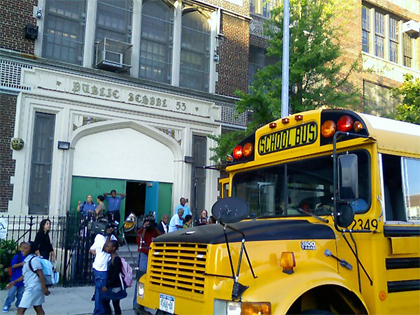
“There’s a lot of work our teachers and principals are doing every day to put us on the path to Equity and Excellence for All, and put our children on the path to success. I look forward to all the work we have ahead of us, and continuing to update you on these reforms and the progress we are making”, says the author.
As an educator for 52 years, I know that all of our schools’ most important work happens in the classroom.
In my first four years as New York City Schools Chancellor, we’ve invested in our classrooms through our Equity and Excellence for All agenda – our belief that every child, no matter what zip code they live in or where their parents were born, deserves a great education.
By any measure, our schools are the strongest they’ve been, with record-high graduation rates, record-high numbers of students going on to college, record-low dropout rates, and improving test scores. We’re building on this progress with 3-K for All, Computer Science for All, and Community Schools. Many of our investments in classrooms across the City – particularly in training teachers and improving classroom instruction – are less splashy and often overlooked, but are just as critical to our vision of Equity and Excellence for All.
Here are a few of those “under the radar” investments that are making an impact in our classrooms:
80 minutes of teacher training. Nearly four years ago, one of the first things I did was set aside 80 minutes at every school every week for teacher training. This is a game-changer for schools and the children and families we serve.
During the 80 minutes, teachers learn how to use new cutting-edge resources; plan for upcoming lessons; and look closely at students’ performance on tests and essays to figure out what they’re teaching well and what they need to do better.
Passport to Social Studies. Since I was a child and my father read Spanish books with me about the history of Spain (his native country), Social Studies has always been my favorite subject. Unfortunately, it was not seen as a priority in schools, but it has to be. We must prepare students to be thoughtful, productive citizens, and they absolutely have to understand history, civics and current events.
Last school year, we released a brand-new Social Studies curriculum, the Passport to Social Studies. I’m happy to say it’s now in over 70 percent of our elementary and middle schools, and I’m excited to see that number grow as more schools focus on Social Studies.
Investments in middle school. If we get middle school right, students can find hobbies and passions, and start carving their path to college and careers. We need to make the investments to reach them and get them ready for high school, college, and beyond.
We now provide an after-school seat for ever middle-school student, and also started a program called “Teen Thursdays,” where 7th-grade students can visit many local cultural institutions. It’s not a given that kids and families feel welcome at their local museums and cultural centers; programs like this connect our students and parents with their City in a new way. We’re also homing in on middle school math through our Algebra for All initiative – making sure students get the math instruction they need in 5th grade and middle school so they’re ready to take on advanced math courses in high school.
Collaboration over competition. I’ve always been a believer in collaboration over competition. It is shameful when a school has great things that are helping kids and doesn’t share those resources. Last school year, we tapped into that collaborative spirit and brought the “co-located campus initiative” to 20 campuses across all five boroughs.
Participating schools are on a single bell schedule so all students on the campus can share AP and enrichment courses, increasing access to more rigorous coursework. Teachers come together for shared professional development, there are family welcome centers to encourage all parents to get involved, and there have even been campus-wide proms. By coming together, schools that would have been siloed are sharing best practices and strengthening campus culture – and students are benefiting.
Family engagement. None of our instructional work can achieve its potential without a strong partnership between families and schools, and increasing family engagement is a central priority.
We’ve increased the number of evening parent-teacher conferences to make them more convenient for families – resulting in a 40 percent increase in conference attendance – and provided additional training to parent coordinators on engaging parents in their school communities. We’re looking at creative new ways to get more families involved in their children’s education, like FaceLab, a robotics and technology course taught by parent volunteers, and the Family English Initiative, an English proficiency course that parents and students take together.
These “under the radar” efforts – and many like them – are making a real impact for children and families across the City. There’s a lot of work our teachers and principals are doing every day to put us on the path to Equity and Excellence for All, and put our children on the path to success. I look forward to all the work we have ahead of us, and continuing to update you on these reforms and the progress we are making.
(The author is the New York City Schools Chancellor)
